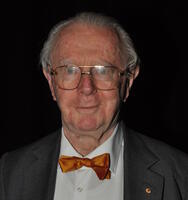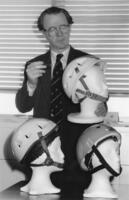
South Australian Medical Heritage Society Inc
Website for the Virtual Museum
Home
Coming meetings
Past meetings
About the Society
Main Galleries
Medicine
Surgery
Anaesthesia
X-rays
Hospitals,other
organisations
Individuals of
note
Small Galleries
Ethnic medicine
- Aboriginal
- Chinese
- Mediterran
Professor Donald Simpson AO, D. Univ, M.D, M.S, FRCS, FRACS, FACRM
A Legacy of Neurosurgery, History, and Compassion (1927-2017)
ACKNOWLEDGEMENTS
We are most grateful to Maggi Boult, on behalf of the SAMHS Committee, for writing this article about the distinguished neurosurgeon, and our past Patron, Professor Donald Simpson.
Professor Donald Adrian Allen Simpson AO was an internationally respected neurosurgeon and medical historian who dedicated his life to advancing neurosurgery in Australia and beyond. His career was distinguished not only by his technical achievements, but by an unwavering commitment to his patients, a passion for the humanities, and a deep sense of community. His biographer, Peter Reilly, described him as 'a good man'.
Growing up in a family with strong roots in South Australia, Donald was the son of Allen and Janet Simpson, noted figures within Adelaide's industrial white goods sector. It is thought that his decision to pursue neurosurgery was influenced by a medical aunt, Ulrica Hubbe and possibly also by his older cousin, the prominent Adelaide ophthalmologist, David Crompton. His father died from a stroke, when he was aged twelve. As a student, Donald excelled, winning the Tennyson Medal for English at school, and the Everard Prize in his final year as top medical student at the University of Adelaide. His academic journey continued at Oxford, where he undertook neuroanatomical research and training in neurosurgery.
At Adelaide University, he had met Joanna Erlistoun Thompson (1926-2007), who, like himself was a talented linguist. She became a cadet at the Department of External Affairs before being posted to Canada. On his way to Oxford, Donald visited her and proposed marriage. They married in London in 1952, once the posting had been completed.
On his return to Adelaide in 1956 Donald began a clinical career that spanned Adelaide's major hospitals, including roles as Director of Paediatric Neurosurgery at the Adelaide Children's Hospital. He also extended the reach of neurosurgery to rural hospitals. Known for his skill and wit, Donald was highly regarded by his colleagues, with many anecdotal stories such as his introduction of "Dinning's Law": "There is no operation that wouldn't be better performed by a neurosurgeon."
Professor Simpson co-founded the Craniofacial Unit at the Royal Adelaide Hospital and the Adelaide Children's Hospital with plastic surgeon Dr. David David. This unit rose to prominence as the top craniofacial surgery centre in Australia, setting a national standard for excellence in treatment. Donald's commitment to paediatric neurosurgery was transformative, especially in treating conditions like hydrocephalus and neurotrauma, and he was instrumental in shaping surgical protocols that have continued to be followed.
Professor Simpson made several pioneering contributions to neurosurgery. His internationally recognized "Simpson Grading" system for meningioma resection which he developed during his time in Oxford continued to be widely used. In 1960, with Dr. Jim Dinning, he inserted the first shunts in South Australia for children with hydrocephalus — a breakthrough that transformed paediatric neurosurgery. He encouraged research on folic acid deficiency and neural tube defects and was involved in an international study that resulted in the preventative use of folic acid in pregnancy.
Throughout his career, Donald maintained an active academic role, eventually becoming a Clinical Professor at the University of Adelaide. A founding member of the Neurosurgical Research Foundation, he helped secure funding for South Australia's first neurosurgical chair at the University of Adelaide. His dedication and enthusiasm were reflected through his neuroanatomy tutorials which inspired many. His academic excellence was recognised in 1985 with the award of a Doctorate of the University of Adelaide. Upon stepping down from his role as Director of Paediatric Neurosurgery in 1985, he joined the NH&MRC Road Accident Research Unit and became a strong advocate for road safety measures such as the use of bicycle helmets.
Donald's interests and contributions extended far beyond medicine. His efforts included fostering international connections, notably through work with Vietnamese medical professionals, and his legacy endures in the global neurosurgical community. Recognized with appointments as a Member (1980) and Officer (2004) of the Order of Australia, Donald's contributions were acknowledged by his peers and the wider public.
A true polymath, Donald pursued his interests in language and history alongside his medical career. He took a diploma in applied history after retiring and produced historical research on notable medical figures and events. His MD Thesis, published in 2000 was titled "The Adelaide Medical School, 1885-1914: a study of Anglo-Australian synergies in medical education". His collection of historic brain-surgery tools was later donated to the South Australian Medical Heritage Society, of which he was a founding member and patron. He published 29 papers on medical history, the last in 2013, and together with his earlier medical publications (including being co-author and co-editor of two books and several book chapters) his total publications numbered 165.
He was a member of the Australian Society of the History of Medicine (now the Australian and New Zealand Society of the History of Medicine), the Centre for British Studies at the University of Adelaide, the Maritime History Society of Australia and the Australian Mining History Association.
Professor Donald Simpson's death in 2018 marked the end of a remarkable life. His legacy endures through his contributions to neurosurgery, his influence in medical education, and his commitment to preserving medical history. His life's work has been honoured in a 2024 biography, "Donald Simpson – Neurosurgeon and Humanitarian", written by Glenn McCulloch and Peter Reilly. All proceeds from the book will be used to fund the Donald Simpson Neuroscience Scholarship, to support junior neuroscientists to advance their research skills.
Timeline
- Born 1927
- Graduated St Peter's School 1943
- Medical School, University of Adelaide, 1944-49, graduated 1949.
- Resident medical officer, Royal Adelaide Hospital, 1950 (published first paper on neuroanatomy)
- Oxford:1951-1956 (studies neuroanatomy then research in neuropathology and training in neurosurgery at the Radcliffe Infirmary)
- Married Joanna Thomson in London in 1952
- Returned to Adelaide 1956 (joined neurosurgeon TAR (Jim) Dinning at the Royal Adelaide Hospital)
- Published highly cited paper on relationship between extent of resection and outcomes for meningiomas 1957
- Visited the New Guinea highlands in 1957 with team investigating Kuru (revisited in 1959).
- Worked at Queen Elizabeth Hospital.
- Member of the Neurosurgical Society of Australasia (NSA) from 1964; secretary from 1969 to 1973, and President from 1973 to 1975.
- Appointed Director of Paediatric Neurosurgery at the Adelaide Children's Hospital (later the Women's and Children's Hospital) in 1970 - 1985.
- Worked and taught at the Cho-Ray Hospital Saigon for some months during the Vietnam War in 1972 and 1973.
- Member of the International Society for Paediatric Neurosurgery from 1973 being President from 1985 to 1986, and a member of the Society for Research into Hydrocephalus and Spina Bifida from 1970.
- First President of the Indo-China Refugee Association established in 1975 (now the Australian Refugee Association)
- Royal Australasian College of Surgeons (RACS) member and chairman of the Surgical Board (Neurosurgery) from 1975 to 1982; member of the Court of Examiners from 1977 to 1986; member of the National Road Trauma Committee, (representing the NSA) from 1986; convener and foundation member of the Section of the History of Surgery and Anaesthesia, now the Section of Surgical History, from 1987.
- Appointed Clinical Reader in the department of Paediatrics at the University of Adelaide in 1982 and Clinical Professor in 1987.
- Foundation Fellow (1980) of the Australian College of Rehabilitation Medicine and a member of numerous national working parties and committees particularly related to head injury.
- Collaborated with Professor David J. David in establishing a Craniofacial unit at the Royal Adelaide Hospital and Adelaide Children's Hospital
- With Dr Annabel Carney he established and conducted a multidisciplinary spina bifida clinic which was a model of its kind
- Collaborated with Professor Jack McLean at the (then) Road Accident Research Unit particularly on crash helmets and the neuropathology of brain injury.
- Part-time position in the NH&MRC Road Accident Research Unit as Senior Research Associate 1985.
- Continued in part-time public and private neurosurgical practice until 1992.
- Foundation member and Chairman of the Neurosurgical Research Foundation, established by Dinning and Simpson 1994 to 2004
- Thesis (MD) awarded 2000
- Died 2018

